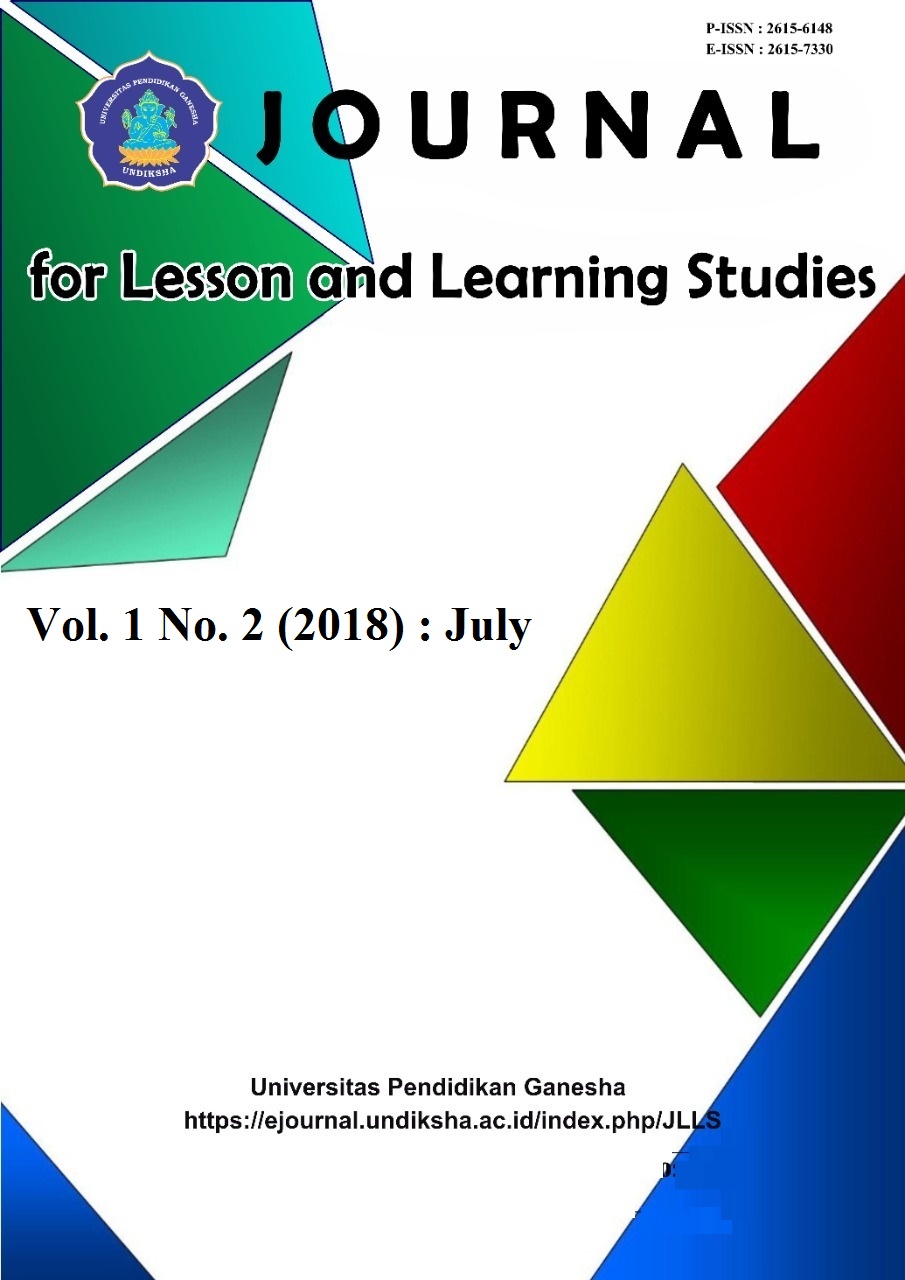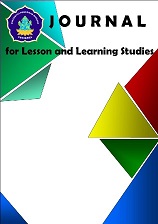PENGARUH MODEL PEMBELAJARAN POGIL BERBANTUAN MEDIA PERMAINAN TTS TERHADAP HASIL BELAJAR IPA SISWA KELAS V SD
DOI:
https://doi.org/10.23887/jlls.v1i2.14718Abstrak
This study aimed at determining the effect of learning model POGIL assisted by crossword puzzle game media toward the learning outcome of natural science grade V primary students in Cluster IV Cempaka Putih, Kubutambahan Sub-district, Buleleng Regency in academic year 2017/2018. This research type was quasi experiment with post test only control group design. The population of this research were the students of grade V of primary school in Cluster IV Cempaka Putih, in academic year 2017/2018 amounting to 168 students. Sample determination was done by random sampling through lottery technique. The instrument of data collection used in this research was objective test. The data obtained were analyzed by descriptive statistical analysis, prerequisite test of data analysis, and hypothesis test through t-test. The results showed that there were significant differences of learning outcome of natural science between groups of students who were taught by POGIL learning model assisted by the media of crossword puzzle and groups of students who were not taught by the learning model of POGIL assisted by the media of crossword puzzles. It was seen from result of t-test calculation obtained tcount = 5,103 and ttable = 2.012 (ttcount> ttable). The differences in the learning outcome of natural science students indicated that the POGIL learning model assisted by crossword puzzle media had a positive effect on learning outcome of natural science on students.
Referensi
Butudoka, Hartati Dj. 2016. “Penerapan Pengamatan Lingkungan Untuk Meningkatkan Hasil Belajar Siswa Pada Pembelajaran IPA di Kelas IV SDN 2 Labuan Lobo Kecamatan Ogodeide Kabupaten Tolitoli”. e Jurnal Kreatif Tadulako, Vol.4, No.3. Tersedia pada: http://jurnal. untad.ac.id/jurnal/ index.php/JKTO/article/view/3415. (diakses tanggal 14 November 2017).
Hanson, David M. 2006.” Instructor’s Guide to Process Oriented Guided Inquiry Learning”. Stony Brook University-SUNY: Pacific Crest. Tersedia pada: https://pogil.org/uploads/media_items/pogil-instructor-sguide1.original.pdf (diakses tanggal 10 November 2017).
Khalilullah. 2012. “Permainan Teka-teki Silang Sebagai Media dalam Pembelajaran Bahasa Arab (Mufradat)”. e-Journal Pemikiran Islam, Volume 37. Tersedia pada: http://ejournal.uin-suska.ac.id/index.php/Anida/article/viewFile/309/292 (diakses tanggal 20 November 2017).
Laksmi, Pt. K., dkk. 2014. “Pengaruh Model Pembelajaran Berbasis Otak (Brain Based Learning) Berbantuan Media Teka-teki Silang terhadap Hasil Belajar IPS Siswa Kelas V SD Gugus I Gusti Ngurah Jelantik”. Jurnal Mimbar PGSD Universitas Pendidikan Ganesha, Vol. 2 No.1.Tersedia pada:http://download. portalgaruda.org/article.php?article=138746&val=1342&title=PENGARUH%20MODEL%20PEMBELAJARAN%20BERBASIS%20OTAK%20(%20BRAIN%20BASED%20LEARNING%20)%20BERBANTUAN%20MEDIA%20TEKATEKI%20SILANG%20TERHADAP%20HASIL%20BELAJAR%20IPS%20SISWA%20KELAS%20V%20SD%20GUGUS%20I%20GUSTI%20NGURAH%20JELANTIK (diakses pada tanggal 21 Januari 2018).
Mahayana, I Made Helly, dkk. 2016. “Pengaruh Model Pembelajaran POGIL dan Minat Belajar Terhadap Pemahaman Konsep IPA Siswa Kelas IV”.e-Jurnal PGSD Universitas Pendidikan Ganesha Jurusan PGSD, Vol. 4, No.1. Tersedia pada: http://ejournal.undiksha.ac.id/index.php/JJPGSD/article/ view/6976 (diakses tanggal 14 November 2017).
Marcelia, Ni Putu Widya. 2016. “Pengaruh Model Pogil Dan Minat Belajar Terhadap Keterampilan Proses Sains pada Siswa Kelas V Sd”. e-Jurnal PGSD Universitas Pendidikan Ganesha Jurusan PGSD, Vol. 4, No. 1. Tersedia pada: https://ejournal. undiksha.ac.id/index.php/JJPGSD/article/viewFile/6959/4749 (diakses tanggal 5 November 2017).
Rantika dan Faisal Abdulah. 2015. “Penggunaan Media Teka-teki Silang dalam Meningkatkan Hasil Belajar Siswa Kelas II pada Pembelajaran Bahasa Arab di Madrasah Ibtidaiyahnurul Iman Pengabuan Kabupaten Pali”. Tersedia pada: http://jurnal.radenfatah.ac.id/index.php/jip/article/download/522/472 (diakses tanggal 13 November 2017).
Shimonson, Shawn R. dan Susan E. Shadle. 2013. “Implementing Process Oriented Guided Inquiry Learning (POGIL) in Undergradute Biomechanics: Lessons Learned by A Novice”. Journal of STEM Education, Volume 14. Tersedia pada: http://ojs.jstem.org/ index.php?journal=JSTEM&page=article&op=view&path%5B%5D=1545 (diakses tanggal 13 November 2017).
Sulastriningsih, Pt. & Kd. Suranata. 2012. “Pengaruh Model Process Oriented Guided InquiryLearning terhadap KemampuanPemahaman konsep IPA Siswa KelasV SD Gugus XI Kecamatan Buleleng”. e-Journal Mimbar PGSD Universitas Pendidikan Ganesha Jurusan PGSD, No. 1 Tahun: 2012. Tersedia pada:http://ejournal.undiksha. ac.id/index.php/JJPGSD/article/view File/820/693 (diakses tanggal 13 November 2017).
Susanto, Ahmad. 2013. Teori Belajar dan Pembelajaran di Sekolah Dasar.
Umam, M. Syaikhul, dkk. 2016. “Pengaruh Model Process Oriented Guided Inquiry Learning (POGIL) terhadap Hasil Belajar dan Retensi Hasil Belajar Siswa pada Pembelajaran Fisika SMA/MA di Kabupaten Jember”. Jurnal Pembelajaran Fisika, Volume 5, No. 3. Tersedia pada: http://download. portalgaruda.org/article.php?article=478762&val=7717&title=PENGARUH%20MODEL%20PROCESS%20ORIENTED%20GUIDED%20INQUIRY%20LEARNING%20(POGIL)%20TERHADAP%20HASIL%20BELAJAR%20DAN%20RETENSI%20HASIL%20BELAJAR%20SISWA%20PADA%20PEMBELAJARAN%20FISIKA%20SMA/MA%20DI%20KABUPATEN%20JEMBER (diakses tanggal 21 Januari 2017).
Yuliani, Ni Putu, dkk. 2017. “Pengaruh Model Pembelajaran POGIL Berbantuan Peta Pikiran Terhadap Hasil Belajar IPA Siswa Kelas V SD”. e-Journal Mimbar PGSD Universitas Pendidikan Ganesha Jurusan PGSD, Vol. 4, No. 2. Tersedia pada: https://ejournal. undiksha.ac.id/index.php/JET/article/view/11773 (diakses tanggal 14 November 2017).
Unduhan
Diterbitkan
Cara Mengutip
Terbitan
Bagian
Lisensi
Authors who publish with the Journal for Lesson and Learning Studies agree to the following terms:
- Authors retain copyright and grant the journal the right of first publication with the work simultaneously licensed under a Creative Commons Attribution License (CC BY-SA 4.0) that allows others to share the work with an acknowledgment of the work's authorship and initial publication in this journal.
- Authors are able to enter into separate, additional contractual arrangements for the non-exclusive distribution of the journal's published version of the work (e.g., post it to an institutional repository or publish it in a book), with an acknowledgment of its initial publication in this journal.
- Authors are permitted and encouraged to post their work online (e.g., in institutional repositories or on their website) prior to and during the submission process, as it can lead to productive exchanges, as well as earlier and greater citation of published work. (See The Effect of Open Access)





